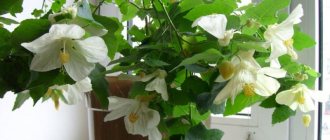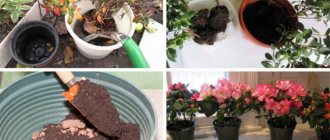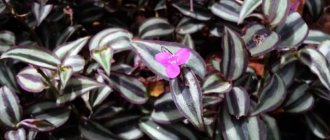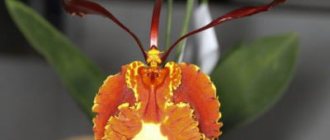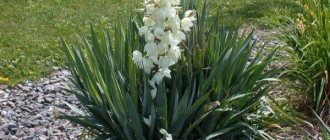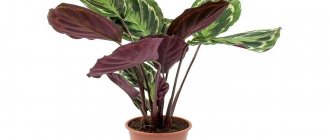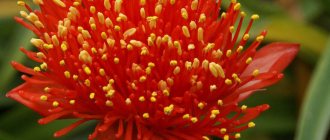Even for a novice gardener, growing abutilone will not seem difficult. This decorative indoor plant is also popularly called maple for the unique shape of its leaves. Abutilon belongs to the malvaceae species, and its homeland is the tropical forests of Brazil, Africa and India. But unlike many foreign indoor plants, it is quite easy to care for.
Flower growers love abutilon for its abundant flowering, which begins in May and lasts until the end of October. When creating optimal lighting, air temperature and humidity, indoor maple can bloom throughout the year, shedding faded inflorescences and delighting owners with new bright flowers.
The genus to which abutilone belongs contains more than 100 species. Flowers can be of very different colors - from pale milky to bright burgundy. In indoor floriculture, the most popular are hybrid and Amazonian varieties of indoor maple.
Acquaintance
The genus of domestic maple belongs to the malvaceae family. It grows naturally in the tropics and subtropics, where it is warm and humid. There it grows in the form of bushes, small trees or perennial grass and has more than 100 species.
Abutilon is the closest relative of indoor hibiscus and mallow.
Abutilon is also called house maple or indoor maple because its leaves are very similar to maple leaves. They have a blade shape, are very flexible and delicate, the edges have small teeth. In India, it is known as rope because its coarse fiber is used to make ropes and also weave various products.
Abutilon flower is a very famous, popular, unpretentious plant that is successfully grown all over the world. It is valued for its rapid growth and spectacular flowering. In good growing conditions, the shrub reaches two meters in height and blooms generously, as seen in the photo, possibly throughout the year.
Unusual bush
Recently I had the opportunity to visit the village of Komarovo in the Kurortny district of St. Petersburg, visiting the composer Grigory Fedorovich Uglov, the son of academician, outstanding surgeon Fyodor Grigorievich Uglov.
There was a persistent smell of roses in the garden, although I did not see these flowers in the area. The aroma came from an unusual bush. Its leaves resembled maple, its flowers looked like rose hips.
It turned out that maple-raspberry, or fragrant raspberry, has been known for a long time, but for some reason it has not become widespread in our current gardens. At home I began to look for information about this wonderful plant. And this is what I managed to find out.
Types of abutilone
Hybrid and decorative types of abutilon are grown at home. It is the variety of hybrid forms of indoor maple that makes it possible to admire plants of any size with a wide variety of leaf and flower colors.
The leaves of adult plants are quite large, up to 10 centimeters. They have a green, motley or spotted color.
The beautiful abutilon flowers, which look like Chinese lanterns or bells, will not leave anyone indifferent. Inflorescences on long stalks can be red, pink, orange, white, golden and other shades of the rainbow. Depending on the shape of the flower, terry and simple types of shrubs are distinguished. Flowering lasts from early spring to late autumn.
Psychologists believe that abutilone has a calming effect, helps relieve nervous tension and even relieve depression.
The most popular types of indoor maple.
Abutilon Juliet
Many gardeners love this type of indoor maple. After all, the plant is very unpretentious, does not require light, and grows quickly. Within a year, Abutilon Juliet grows up to half a meter in height. The plant pleases with its flowers, without ceasing, all year round. The flowers are bright, large, each about six centimeters in diameter. It begins to bloom six months after sowing the seeds.
Abutilon Amazonian
This species is also known as Abutilon megapotamus, or weeping Chinese lantern. Each flower of the plant is very similar to a lantern. It is yellow in color, has a crimson beginning and a fiery red corolla. In good habitat conditions, Abutilon megapotamii blooms almost constantly. The leaves are medium in size, oblong in shape with uneven teeth.
Abutilon Bella
A very compact and decorative plant, it is characterized by great branching and large bright flowers that practically fill the branches. Pink, white or gold flowers look spectacular against green foliage. Abutilon Bella does not grow higher than forty centimeters, it does not need pruning or pinching and blooms beautifully all year round. That's why all gardeners adore him. The bush will perfectly complement any interior design; bright flowers will fill the house with comfort and beauty. This species is similar to the Abutilon variety - Isabella, which is characterized by bright flowers of even larger size.
Abutilon Bellevue
This type of Abutilon is a hybrid, the Bellevue mixture forms a plant up to two meters in height, with timely pruning and proper care, it has the shape of a beautiful and lush bush. The flowers of the bush can be of all colors of the rainbow.
Abutilone Victorian lady
Also known as Abutilon terry. A medium-growing variety, the flowers are lush, double, and have a soft pink color.
Grape leaf abutilone
The leaves of the plant are similar to grape leaves, hence the name of the variety. They are green, velvety, have a small fluff underneath, the leaves are about fifteen centimeters long. Several flowers are collected in clusters and fall beautifully on long stems. The most common flowers are blue and lilac. Flowering occurs in May.
Crown formation
In autumn and spring, the shoots of indoor maple should be shortened by half, otherwise the plant can grow up to 1.5 meters in height over the season. It is necessary to trim the branches before the plant blooms - this is very important. It is recommended to prune weak shoots.
If you remove all lateral shoots up to a certain height, leaving one main stem, you can get a small home tree from the plant.
To form a beautiful lush bush from abutilone , you must remember to pinch the tops of young shoots in time.
Caring for abutilone at home
All varieties of indoor maple are unpretentious in care. But in order to enjoy a beautifully flowering plant, you must follow some rules.
- Lighting and temperature conditions
Indoor maple Abutilon is a very light-loving flower. A room with a lot of daylight is suitable for him, but at the same time he will not like too bright light. In summer, you can take it out into the fresh air, onto a balcony or veranda, choosing a shaded place. If there is a lack of light, the plant will not want to bloom.
In summer, the optimal temperature in the room where Abutilon grows should be no lower than +20 - +25 degrees. In winter, the temperature may drop to +10 - +15 degrees, but it should be remembered that if the plant stays in a room with a temperature of +10 degrees for a long time, it will begin to dry out.
- Watering
During the period of active growth of the bush, that is, in the warm season, home maple needs regular and abundant watering. Watering should not be reduced while the plant is blooming. A couple of hours after watering, the excess water that has accumulated in the pan needs to be poured out. Starting from November, watering is reduced and carried out moderately throughout the rest period, until February.
Remember
When the soil becomes waterlogged or dries out, abutilon can shed its thick crown and flowers.
- Air humidity
The plant is very moisture-loving, so if the room is hot, it must be frequently sprayed with water. When the bush blooms, spraying should be done carefully, avoiding water getting on the flowers.
- Fertilizing the plant
Abutilone needs feeding: mineral and organic fertilizers. Fertilize the plant regularly once a week. In early spring, when the plant is actively growing, gaining green mass, it is recommended to apply nitrogen, and before flowering it is better to fertilize the bush with phosphorus and potassium. There is no need to fertilize the plant in winter.
- Abutilone pruning
Scheme for pruning indoor plants
To get a bush of the correct size and required height, the plant needs timely pruning. In addition, Abutilon grows very quickly and pruning shoots is very important for it.
In early spring, before active growth begins, shoots are shortened by 1/3 or 2/3 of their length. Pruning indoor maple not only contributes to the formation of a beautiful crown, but also stimulates abundant flowering.
For young plants, pinching the tops should be done. Next, the bush needs to be moved to a warm room, watered and fed abundantly.
- Abutilone transplant
Abutilon needs annual replanting. You should not choose a container for replanting that is much larger than the previous one. The plant will begin to bloom once its roots have completely covered the soil. It is better to take soil for planting from flower shops, where it is already saturated with beneficial properties and disinfected from parasites.
Important points
When growing Abutilone, it should be noted that the plant:
- does not tolerate direct sunlight;
- afraid of drafts;
- perfect for organizing flower beds;
- in the summer you will feel better in the open ground;
- Suitable for greenhouses and large rooms.
Abutilone is a fast-growing large plant that requires free placement, so it is recommended to grow it in spacious rooms. This abundantly and long-blooming tree with delicate foliage will decorate any interior.
How to grow Abutilon
Indoor maple can reproduce using cuttings or seeds.
Propagation by cuttings
For cuttings, choose a cutting up to twelve centimeters long with a flexible trunk. The buds and lower leaves are torn off from them. To plant cuttings, it is better to use a ready-made store-bought substrate or a mixture of peat and sand. The cuttings should be planted in small cups, after which they should be covered with jars. In this way, greenhouse conditions are created, and within a month the root system of seedlings is formed. During this period they should be watered, ventilated and sprayed. Next, the sprouted cuttings are transplanted into pots with a diameter of no more than seven centimeters.
Remember
Abutilon can be propagated by cuttings at any time of the year, but the most favorable period for this is the month of August.
Propagation by seeds
Growing Abutilon from seeds at home is very simple. Those who have already done this know that the seeds of this plant have almost 100% germination rate.
Before sowing seeds, it is necessary to prepare the soil. It is recommended to sift the soil so that it is looser and retains moisture better, and also to treat it with a solution of potassium permanganate to disinfect it from various fungi and bacteria. To prepare the soil, you can take: two parts of peat and leaf soil, one part each of river sand and vermiculite.
Abutilone seeds
Before sowing, it is imperative to check the integrity of the seed shell; if the shell is damaged, then such seeds are unlikely to germinate. Good seeds should be dark in color. Before planting, they can be soaked simply in warm water or in a growth stimulator solution for twelve hours. Plant the seeds in moist soil to a depth of about five millimeters, cover with film and place in a warm, sunny place. After three weeks, the first shoots appear.
When the first maple leaf appears, it means that the seedlings are ready for picking. In order for the plant to grow faster, for replanting you should take cups no more than seven centimeters in diameter.
Now you just need to properly care for the seedlings: monitor lighting, temperature, humidity. Apply mineral fertilizers once a month.
Growing the plant this way makes it much stronger and more resilient. In addition, when growing Abutilon from seeds, you can choose exactly the variety that you like the most, you can even sow several different varieties in one pot.
Already six months after sowing the Abutolin seeds, the plant will delight others with its flowers.
Foreign greetings
Returning from a visit with the treasured shoot, I thought, maybe the maple-raspberry was brought from Russian America, from the shores of Alaska, where our first settlers mined fur? I immediately remembered the navigator Rezanov, his ships “Juno” and “Avos”...
Or maybe the bush was brought from a trip to Western Europe, where maple-raspberry was introduced into cultivation in 1770?
But whoever the person who brought the bush to us was, he was just like us, a passionate lover of flowers...
PS.> Planting root shoots, a section of the bush, is shallow (15-20 cm). In spring, dead shoots are cut off. Standard care: in spring - nitrogen fertilizing, loosening, watering in severe drought.
Author of the article: Elena Valentinovna Perlova, Shlisselburg, Leningrad region.
Source
Diseases and pests of home maple
Dangerous pests for Abutilon are scale insects, mealybugs, whiteflies, aphids and spider mites. It is important to frequently inspect the plant, especially the lower leaves, which often become a haven for various parasites. If the indoor maple is nevertheless exposed to pests, then they need to be combated with special chemicals that are available in flower shops.
Common problems
Although the Abutilon maple is an unpretentious plant, if the care technology is not followed, some problems arise:
- leaves and tops dry and curl - bright light, lack of watering or dry air;
- leaves turn yellow and become spotted - lack of microelements;
- stems stretch out - lack of lighting;
- the plant sheds leaves and buds - excessive soil moisture, or, conversely, its drying out, strong drafts, temperature changes.
Abutilon - indoor maple
Anyone can grow the beautiful Abutilon, an indoor maple tree. You just need to give it a little care and attention, and the plant will thank you with lush branches of leaves and bright flowers. Collectors of flowering plants enjoy growing this spectacular flowering shrub.
Red-leaved barberries
Among the many varieties of this thorny shrub, there are many brightly colored ones - including all shades of purple. Cabernet, Ottawan Auricoma, Red Carpet, Orange Rocket, Harlequin, Coronita - this is not a complete list of red-leaved barberries.
These plants are unpretentious, grow quickly, are easy to formative pruning, and look great on the site both as a tapeworm and as part of a spectacular hedge.
Decorative apple tree
Among fruit trees, it is also worth remembering red-leaved apple trees, which will undoubtedly decorate any area. Even if the fruits of the variety of such a tree you choose do not have an amazing taste, many of them add decorative value to such a crop throughout the season, remaining on the branches not only in late autumn, but sometimes in winter. And during flowering, decorative apple trees present an absolutely incredible sight.
The advantage of ornamental apple trees is their unpretentiousness. You can care for them like regular apple trees. In addition, the trees are winter-hardy and drought-resistant, and you can also choose the variety of the height and crown shape you need.
The best varieties of ornamental apple trees: Weeping (Prirechnaya), Nedzvetsky (Purple), Royalty, Pioneer, Red-leaved red-berry, Paradise, Weeping red-leaved, Profusion.
